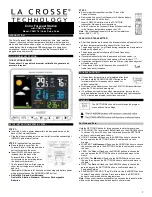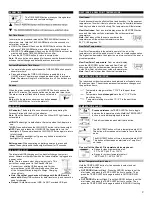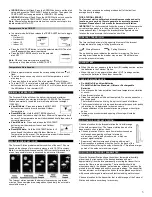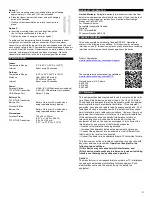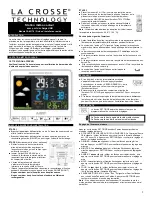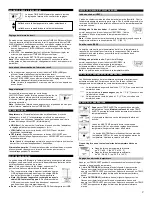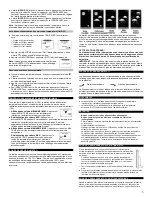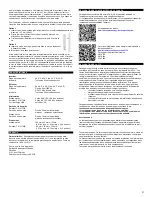
4
Option 1:
Install one mounting screw (not included) into a wall leaving
approximately ½ of an inch (12.7mm) extended.
Place the transmitter onto the screw, using the hanging
hole on the backside.
Gently pull the transmitter down to lock the screw into
place.
Option 2:
Insert the mounting screw (not included) through the
front of the transmitter and into the wall.
Tighten the screw to snug (do not over tighten).
To achieve a true temperature/humidity reading, mount where direct
sunlight cannot reach the outdoor transmitter. Mount the outdoor
transmitter on a North-facing wall or in any well shaded area. Under an
eave or deck rail work well. The maximum transmitting range in open air
is over 200-feet (60 meters). Obstacles such as walls, windows, stucco,
concrete, and large metal objects can reduce the range. Place the
transmitter at least 6 feet in the air to improve signal transmission.
SPECIFICATIONS:
Indoor
:
Temperature Range:
0°C to 50°C (+32°F to +122°F)
Interval:
About every 30 seconds
Outdoor
:
Temperature Range:
-40°C to 60°C (-40°F to 140°F)
Distance:
Over 200 ft. (60 meters)
RF 433MHz (open air)
Interval:
About every 50 seconds
Power:
Forecast Station:
3-AAA, IEC, LR6 batteries (not included)
TX141TH-B Transmitter:
2-AA, IEC, LR6 batteries (not included)
USB Charge Port:
Output 1.0 amp
Battery Life:
TX141TH-B Transmitter
Battery Life:
Battery life is over 24 months when
using reputable battery brands.
Forecast Station
Battery Life:
Battery life is over 12 months when
using reputable battery brands.
Dimensions:
Forecast Station:
150 x 42 x 123 mm
(
5.91”L x 1.66”W x 4.84”H)
TX141TH-B Transmitter: (40 x 20 x 130 mm
(1.57" L x 0.79" W x 5.12" H)
WARRANTY INFORMATION:
Limited Warranty:
Springfield warrants this instrument to be free from
defects in workmanship and material for a period of 1 year from date of
purchase, and will repair or replace it at our option, without charge.
Please call 1-800-661-6721
For Warranty Service:
Springfield Instruments Canada
Warranty
5151 Thimens Blvd
St Laurent, Quebec H4R 2C8
CANADA STATEMENT:
This device complies with Industry Canada RSS-210. Operation is
subject to the following two conditions: (1) this device may not cause
interference, and (2) this device must accept any interference, including
interference that may cause undesired operation of the device.
Product Registration:
www.lacrossetechnology.com/support/register
The complete instruction manual is available at:
www.lacrossetechnology.com/ca85176
Protected under U.S. Patents:
5,978,738
6,076,044
6,597,990
FCC Statement
This equipment has been tested and found to comply with the limits
for a Class B digital device, pursuant to part 15 of the FCC Rules.
These limits are designed to provide reasonable protection against
harmful interference in a residential installation. This equipment
generates, uses and can radiate radio frequency energy and, if not
installed and used in accordance with the instructions, may cause
harmful interference to radio communications. However, there is no
guarantee that interference will not occur in a particular installation.
If this equipment does cause harmful interference to radio or
television reception, which can be determined by turning the
equipment off and on, the user is encouraged to try to correct the
interference by one or more of the following measures:
—Reorient or relocate the receiving antenna.
—Increase the separation between the equipment and receiver.
—Connect the equipment into an outlet on a circuit different from
that to which the receiver is connected.
—Consult the dealer or an experienced radio/TV technician for help.
This device must not be co-located or operating in conjunction with
any other antenna or transmitter
. Operation is subject to the
following two conditions:
(1) this device may not cause harmful interference, and
(2) this device must accept any interference received, including
interference that may cause undesired operation.
Caution!
The manufacturer is not responsible for any radio or TV interference
caused by unauthorized modifications to this equipment. Such
modifications could void the user authority to operate the
equipment.

